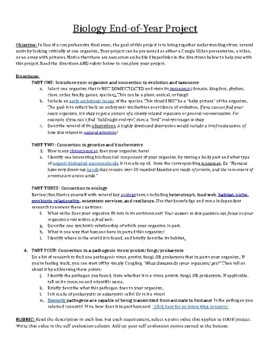Biology Final Project
Bosco Biology and Physical Science
8 Followers
Resource Type
Standards
NGSSHS-LS4-1
NGSSHS-LS4-4
NGSSHS-LS2-8
Formats Included
- Word Document File
Pages
2 pages
Bosco Biology and Physical Science
8 Followers
What educators are saying
I used this as the starting point for an end of the year project (post EOC) for my honors biology classes. It was a HUGE hit!
We loved this project! This was a wonderful way to show learning we gained throughout the year. My students were able to produce excellent projects. Thank you :)
Description
This end-of-year project is designed to bring together understandings from units taught throughout a biology course. It has students focus critically on one organism, looking at it briefly through the lenses of genetics, biochemistry, evolution, taxonomy, and ecology. Rubric and hyperlinks to help students review are included!
Total Pages
2 pages
Answer Key
Rubric only
Teaching Duration
N/A
Last updated May 27th, 2020
Report this resource to TPT
Reported resources will be reviewed by our team. Report this resource to let us know if this resource violates TPT’s content guidelines.
Standards
to see state-specific standards (only available in the US).
NGSSHS-LS4-1
Communicate scientific information that common ancestry and biological evolution are supported by multiple lines of empirical evidence. Emphasis is on a conceptual understanding of the role each line of evidence has relating to common ancestry and biological evolution. Examples of evidence could include similarities in DNA sequences, anatomical structures, and order of appearance of structures in embryological development.
NGSSHS-LS4-4
Construct an explanation based on evidence for how natural selection leads to adaptation of populations. Emphasis is on using data to provide evidence for how specific biotic and abiotic differences in ecosystems (such as ranges of seasonal temperature, long-term climate change, acidity, light, geographic barriers, or evolution of other organisms) contribute to a change in gene frequency over time, leading to adaptation of populations.
NGSSHS-LS2-8
Evaluate evidence for the role of group behavior on individual and species’ chances to survive and reproduce. Emphasis is on: (1) distinguishing between group and individual behavior, (2) identifying evidence supporting the outcomes of group behavior, and (3) developing logical and reasonable arguments based on evidence. Examples of group behaviors could include flocking, schooling, herding, and cooperative behaviors such as hunting, migrating, and swarming.



